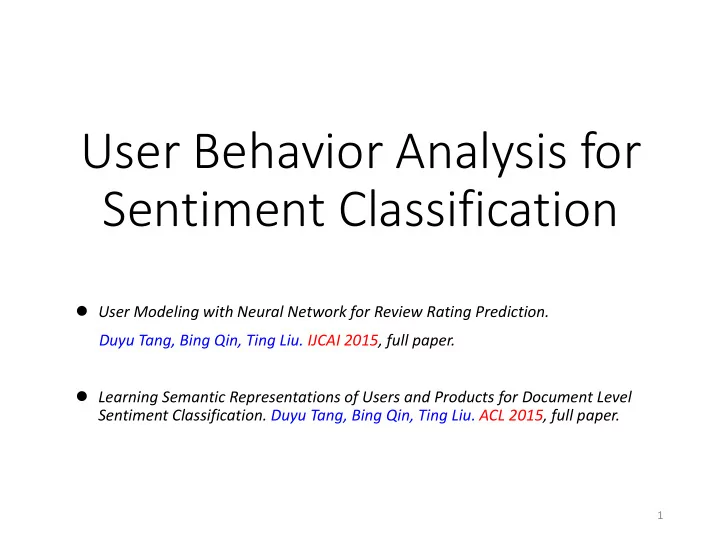

User Behavior Analysis for Sentiment Classification User Modeling with Neural Network for Review Rating Prediction. Duyu Tang, Bing Qin, Ting Liu. IJCAI 2015, full paper. Learning Semantic Representations of Users and Products for Document Level Sentiment Classification. Duyu Tang, Bing Qin, Ting Liu. ACL 2015, full paper. 1
Sentiment Classification • Given a piece of text, the task aims to determine its polarity as • Positive / Negative • 1-5 stars • The task can be at • Word/phrase level, sentence level, document level • We target at document-level sentiment classification in this work 2
Standard Supervised Learning Pipeline Training Data Feature Representation Learning Algorithm Sentiment Classifier 3
Feature Learning Pipeline Training Data Learn text representation/feature from data! Feature Representation Learning Algorithm Sentiment Classifier 4
Deep Learning Pipeline Training Data Semantic Composition Feature Representation Word Representation w 1 w 2 …… Learning w n−1 w n Words Algorithm Sentiment Classifier 5
User Behavior is important for SA • From a sentiment analysis perspective , users have different habits to • Assign ratings on IMDB, Yelp … • Use diverse sentiment words to express one’s sentiment Rating Histories Frequently used words good, ok, just soso, User 1 disgusting… awesome, amazing, User 2 excellent, not bad… 6
The Approach • Text semantics gold rating = 2 Softmax v d Pooling Convolution Tanh h 1 h 2 h n Linear …… Lookup w 1 w 2 w n w i : word 7
The Approach • Text semantics • +User-Text Associations gold rating = 2 Softmax v d The model in IJCAI 2015 Pooling Convolution Tanh h 1 h 2 h n Linear × × …… × Lookup U k w 1 U k w 2 U k w n U k : user w i : word 8
The Approach • Text semantics • +User-Text Associations • +User-Sentiment Associations gold rating = 2 Softmax u k v d Pooling Convolution Tanh h 1 h 2 h n Linear × × …… × Lookup U k w 1 U k w 2 U k w n U k : user w i : word 9
The Approach • Text semantics • +User-Text Associations +Product-Text Associations • +User-Sentiment Associations +Product-Sentiment gold rating = 2 Softmax u k v d p j The model in ACL 2015 Pooling Convolution Tanh h 1 h 2 h n Linear × × × × …… × × Lookup U k w 1 P j w 1 U k w 2 P j w 2 U k w n P j w n P j : product U k : user w i : word 10
Experiments • We conduct supervised learning on three datasets • Some details • We build the datasets by ourselves. • Split each corpus into training, development and testing sets with a 80/10/10 split • IMBD is from Diao et al. 2014 • Yelp 2013 & 2014 come from Yelp Dataset Challenge 11
Experimental Results • On IMDB dataset Our Approach 12
Experimental Results • On Yelp 2014 dataset Our Approach 13
Experimental Results • On Yelp 2013 dataset Our Approach 14
In Summary • We encode users (and products) in semantic vector space, and apply them to sentiment classification. • User and product representations can improve the sentiment classification accuracy. 15
Thanks! codes and resources will be publicly available at: http://ir.hit.edu.cn/~dytang 16
Recommend
More recommend